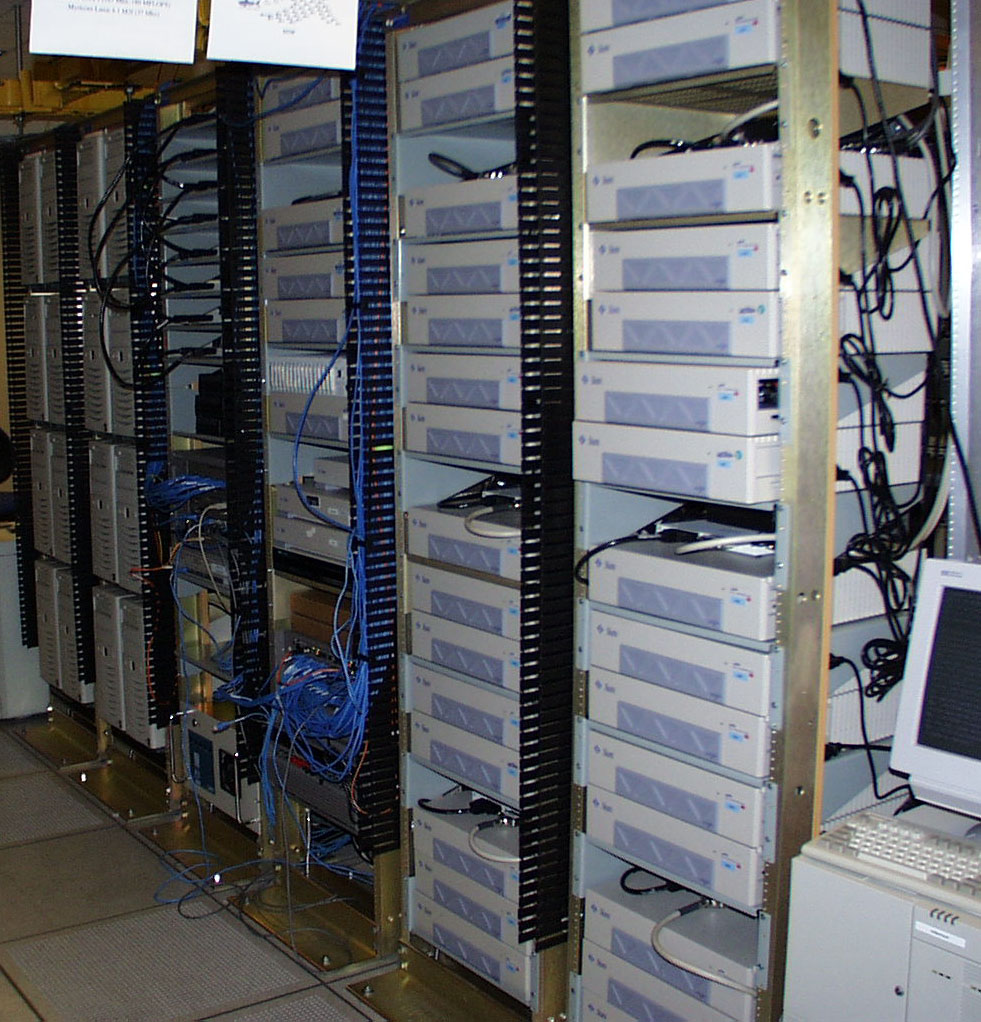|
|
|
  NOW-2
(1997) 105 Ultra-1 workstations (each with a 167 MHz UltraSPARC micro-
processor, 128 MB of memory, and 2 Seagate Hawk 2 GB 5400 RPM 3.5 inch
disks) connected Myrinet switched system area network with each link operating
at 160 MBytes/second. NOW-2
(1997) 105 Ultra-1 workstations (each with a 167 MHz UltraSPARC micro-
processor, 128 MB of memory, and 2 Seagate Hawk 2 GB 5400 RPM 3.5 inch
disks) connected Myrinet switched system area network with each link operating
at 160 MBytes/second. |
![[T0 die]](t0small.jpg) T0
(1995) includes a MIPS-II 32-bit integer RISC core, a 1 KB instruction
cache, a fixed-point vector coprocessor, and a 128-bit wide external memory
interface. Fabricated in a 1.0 micron CMOS process, the die measures 280
mm2, contains 730,701 transistors, and runs at 45 MHz. T0
(1995) includes a MIPS-II 32-bit integer RISC core, a 1 KB instruction
cache, a fixed-point vector coprocessor, and a 128-bit wide external memory
interface. Fabricated in a 1.0 micron CMOS process, the die measures 280
mm2, contains 730,701 transistors, and runs at 45 MHz. |
 Tertiary
Disk (1997) consists of a cluster of 20 PCs which host 396 8.4
GB, 7200 RPM, 3.5-inch IBM disks contained in seven 7-foot high, 19-inch
wide racks. The PCs are P6-200MHz with 96 MB of DRAM each. They run FreeBSD
3.0 and the hosts are connected via switched 100Mbit/second Ethernet. Tertiary
Disk (1997) consists of a cluster of 20 PCs which host 396 8.4
GB, 7200 RPM, 3.5-inch IBM disks contained in seven 7-foot high, 19-inch
wide racks. The PCs are P6-200MHz with 96 MB of DRAM each. They run FreeBSD
3.0 and the hosts are connected via switched 100Mbit/second Ethernet. |
 VLSI-BAM
(1990) is a RISC microprocessor with support for Prolog.
Fabricated in 1.2 micron CMOS the die measures 169 mm2, contains
112,000 transistors, runs at 20 MHz and consumes 1 Watt at 5 Volts. VLSI-BAM
(1990) is a RISC microprocessor with support for Prolog.
Fabricated in 1.2 micron CMOS the die measures 169 mm2, contains
112,000 transistors, runs at 20 MHz and consumes 1 Watt at 5 Volts.
|
 RAID-II
(1993) consisted of three racks. The outer two racks contained 144
disks (3.5 inch IBM 320 MB SCSI) and their power supplies. The center rack
contains three chassis: the top chassis holds VME disk controller boards
(Interphase Cougar), the center chassis contains the custom crossbar switch
(XBUS) and HIPPI interface boards; and the bottom chassis contains the
Sun 4/280 workstation. This network attached storage devise was connected
over 100 megabyte over second HIPPI network (UltraNet). RAID-II
(1993) consisted of three racks. The outer two racks contained 144
disks (3.5 inch IBM 320 MB SCSI) and their power supplies. The center rack
contains three chassis: the top chassis holds VME disk controller boards
(Interphase Cougar), the center chassis contains the custom crossbar switch
(XBUS) and HIPPI interface boards; and the bottom chassis contains the
Sun 4/280 workstation. This network attached storage devise was connected
over 100 megabyte over second HIPPI network (UltraNet). |
   SPUR
chips (1988) This custom chip set enabled a multi- processor
workstation. The processor is 170 mm2, contains 115,214 transistors,
was fabbed in a 1.6 micron CMOS, and operates at 10 MHz. It contains a
RISC processor designed to run Lisp well. The snooping cache controller
is 130 mm2 in the same technology and contains 68,385
transistors. The floating point unit is 130 mm2 in the
same technology and contained about 110,000 transistors. SPUR
chips (1988) This custom chip set enabled a multi- processor
workstation. The processor is 170 mm2, contains 115,214 transistors,
was fabbed in a 1.6 micron CMOS, and operates at 10 MHz. It contains a
RISC processor designed to run Lisp well. The snooping cache controller
is 130 mm2 in the same technology and contains 68,385
transistors. The floating point unit is 130 mm2 in the
same technology and contained about 110,000 transistors. |
 RAID-I
(1989) consisted of a Sun 4/280 workstation with 128 MB of DRAM, four
dual-string SCSI controllers, 28 5.25-inch SCSI disks and specialized disk
striping software. RAID-I
(1989) consisted of a Sun 4/280 workstation with 128 MB of DRAM, four
dual-string SCSI controllers, 28 5.25-inch SCSI disks and specialized disk
striping software. |
 SOAR
(1984) A 32-bit RISC chip designed to run Smalltalk. It contains 35,700
transistors, size is 89 mm2, was fabbed in 4 micron NMOS, dissipates
3W, and runs at 2.5 MHz. SOAR
(1984) A 32-bit RISC chip designed to run Smalltalk. It contains 35,700
transistors, size is 89 mm2, was fabbed in 4 micron NMOS, dissipates
3W, and runs at 2.5 MHz. |

As part of Project Genie (1964-65), Berkeley adds paged virtual memory to a SDS 930, which SDS then sells as the SDS 940 in April 1966. L. Peter Deutsch, Butler Lampson, and Chuck Thacker worked on this as students of Professor Bob Evans. |
 RISC-II
(1983) contains 40,760 transistors, was fabbed in 3 micron NMOS, ran
at 3 MHz, and the size is 60 mm2. RISC-II
(1983) contains 40,760 transistors, was fabbed in 3 micron NMOS, ran
at 3 MHz, and the size is 60 mm2. |
 California
Digital Computer (CALDIC) (1951) This easy-to-understand, low-cost
computer was developed by Berkeley students like Doug Englebart and Al
Hoagland, and led by Professor Paul Morton. California
Digital Computer (CALDIC) (1951) This easy-to-understand, low-cost
computer was developed by Berkeley students like Doug Englebart and Al
Hoagland, and led by Professor Paul Morton. |
 RISC-I
(1982) Contains 44,420 transistors, fabbed in 5 micron NMOS, with a
die area of 77 mm2, ran at 1 MHz. This chip is probably the
first VLSI RISC. RISC-I
(1982) Contains 44,420 transistors, fabbed in 5 micron NMOS, with a
die area of 77 mm2, ran at 1 MHz. This chip is probably the
first VLSI RISC. |